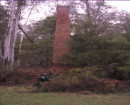PORTLAND LIFEBOAT
PORTLAND MARITIME DISCOVERY CENTRE, LEE BREAKWATER ROAD PORTLAND, GLENELG SHIRE
-
Add to tour
You must log in to do that.
-
Share
-
Shortlist place
You must log in to do that.
- Download report
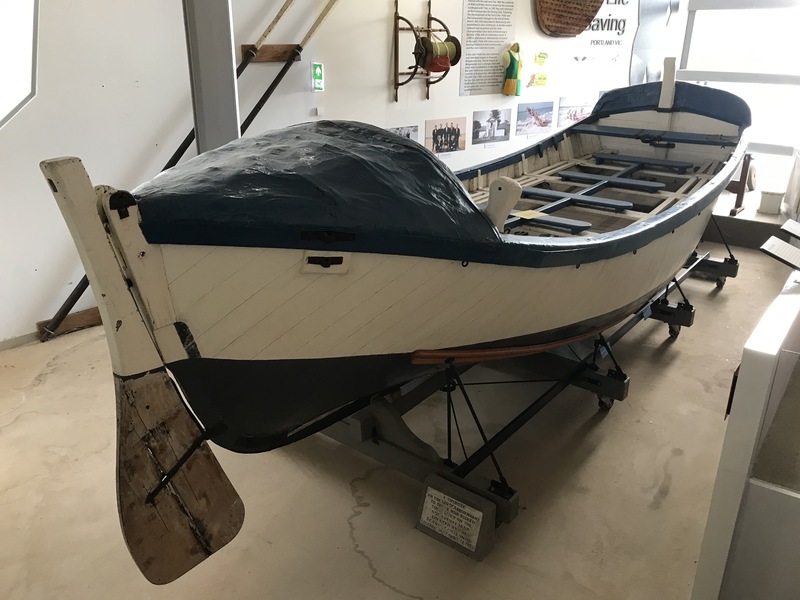

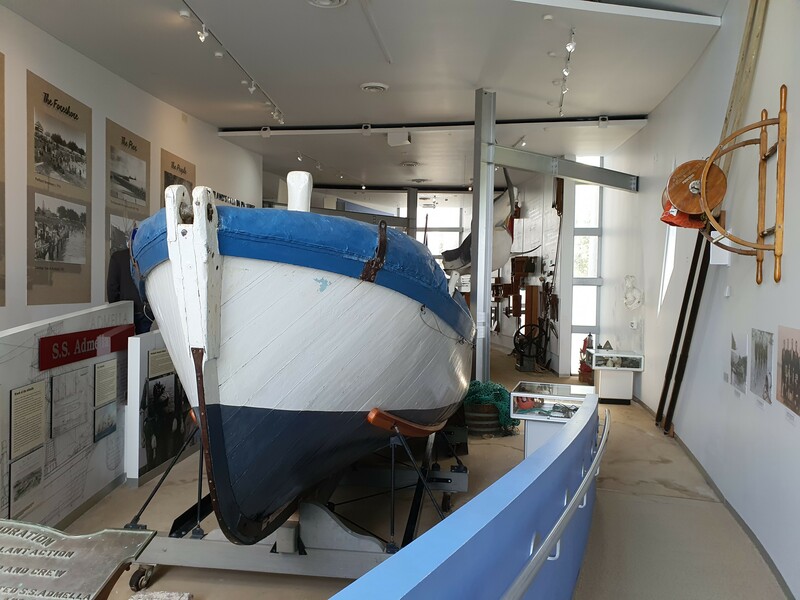
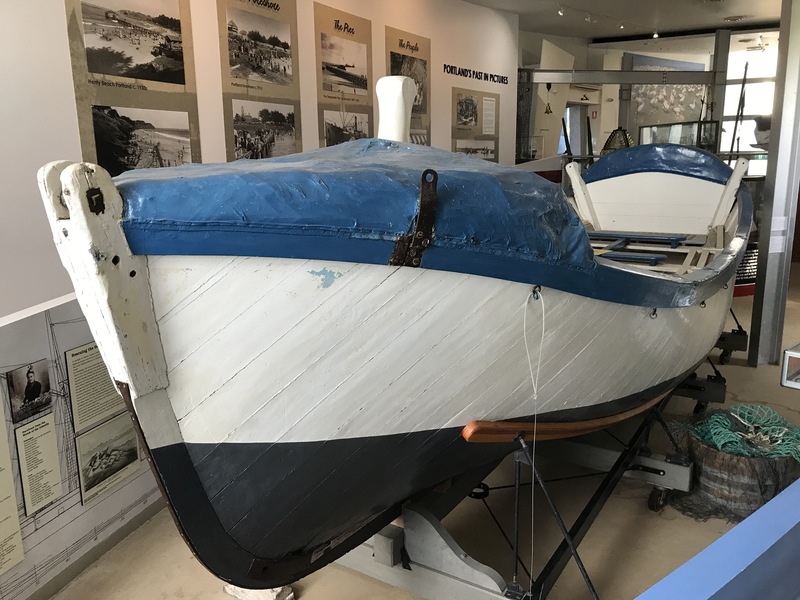
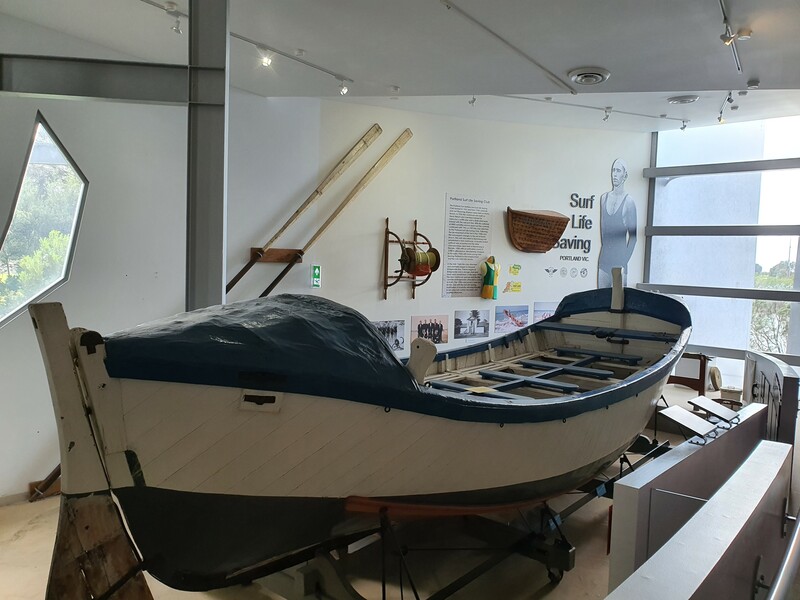
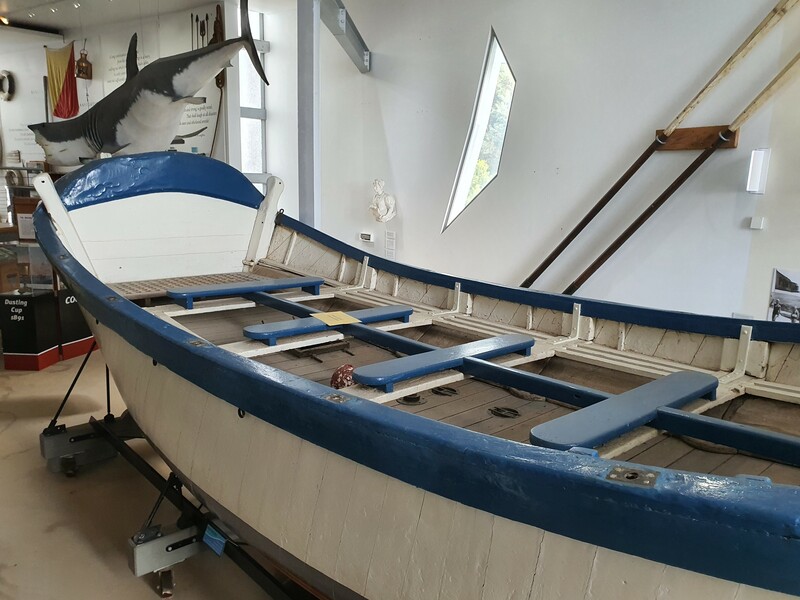
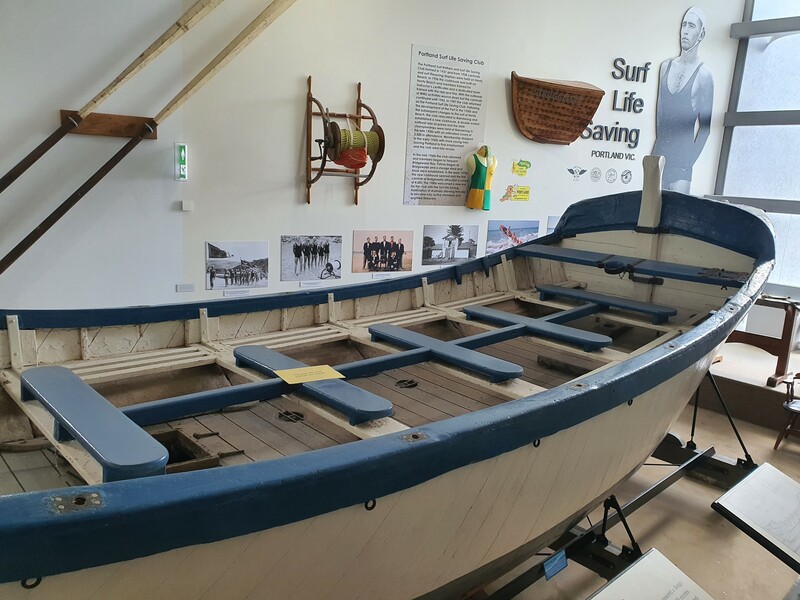
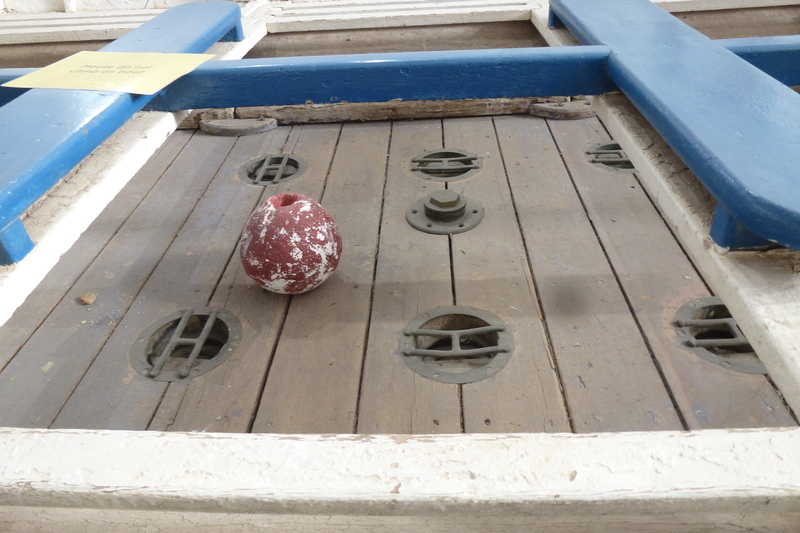
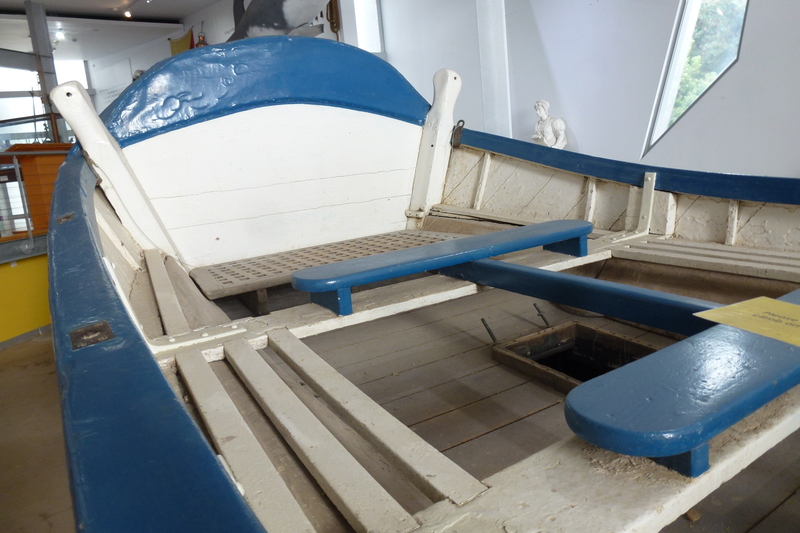
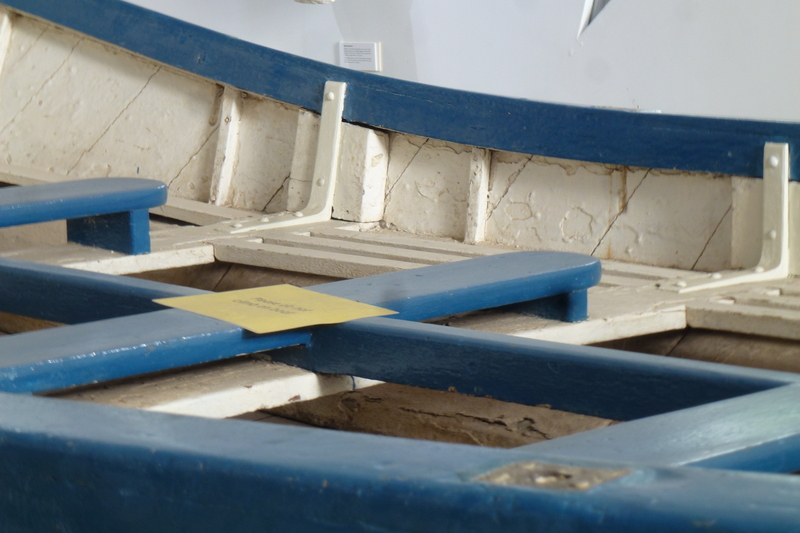
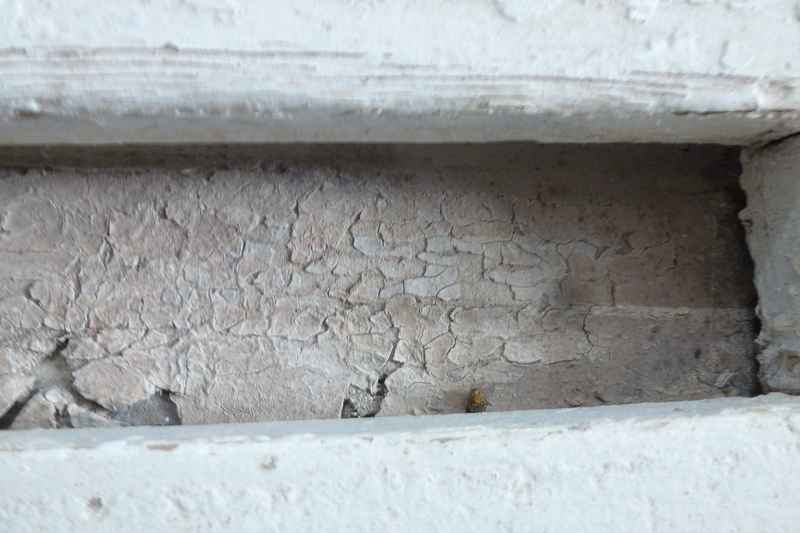
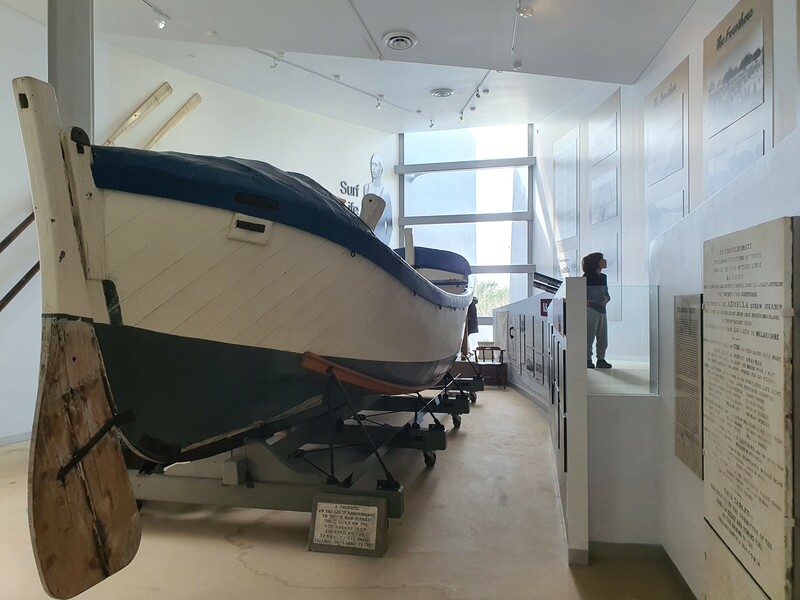
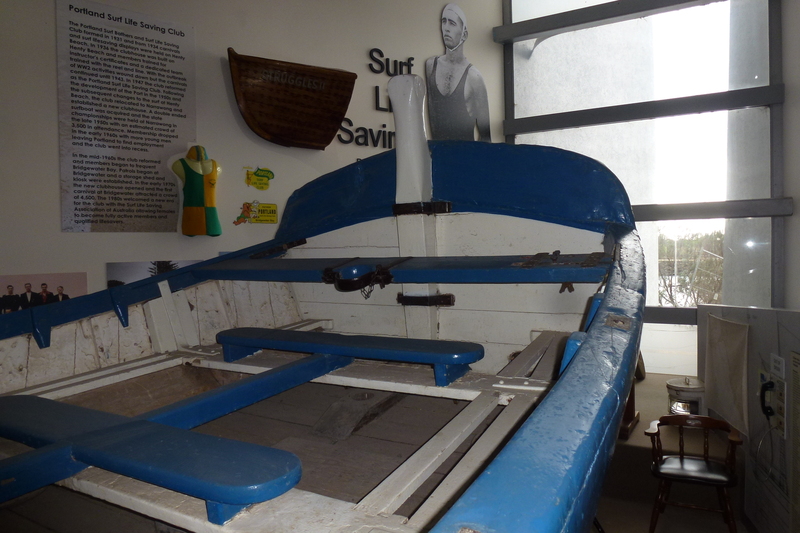
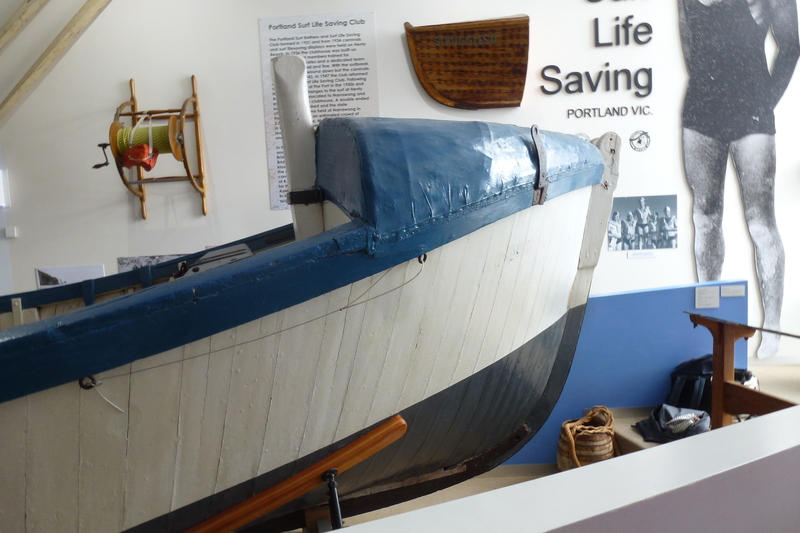
Statement of Significance
What is significant?
How is it significant?
Why is it significant?
The Portland Lifeboat is historically significant for its association with the movement to commemorate tragic shipwrecks and celebrate successful rescues.
-
-
PORTLAND LIFEBOAT - History
Self-righting lifeboat design
The National Institution for the Preservation of Lives and Property from Shipwreck was founded in the United Kingdom in 1824. It became the Royal National Lifeboat Institution (RNLI) in 1854. As well as running rescue services, the organisation also developed shipwreck lifesaving equipment. For example, the cork life preservers they developed in 1854 remained in use until the 1900s. In 1851 the organisation’s president the Duke of Northumberland offered a prize of 100 guineas to design a new lifeboat which was required to have the following attributes:“1. Extra buoyancy2. Self-relief of water3. Ballasting4. Self-righting5. Stability6. Speed7. Stowage-room8. Strength of build”Initially a design by James Beeching was selected. The RNLI then had this design modified by James Peake, Assistant-Master-Shipwright in H.M. Dockyard at Woolwich and in 1852 adopted this design. The design was published in the October 1856 Journal of the National Life-Boat Institution. Measured drawings of the adopted lifeboat design were commissioned by the RNLI in 1857 and were sent to the five colonial governors of Australia. These drawings arrived in Melbourne in February 1858.
Victorian lifeboat service
The Chief Harbour Master of Victoria, Captain Charles Ferguson (ca.1813-1868), was appointed in 1852. A whaleboat at Port Phillip Heads was initially used as a lifeboat. Ferguson began to develop a lifeboat service probably because shipping numbers were increasing rapidly at the time as were shipwrecks. The service established was operated by volunteers and funded by the Department of Trade and Customs which had responsibility for Ports and Harbours. The department provided the boats, equipment and procedures. This equipment included life jackets, comprehensive rescue equipment and rocket apparatus. Rockets were an essential part of lifeboat operations being used both to call crews to assemble in an emergency and to shoot ropes from the lifeboat to the shipwreck survivors during a rescue. Therefore, lifeboat operations required both a lifeboat shed, and a rocket shed. Lifeboat sheds were typically located near the water and made of timber, while rocket sheds were made of masonry in order to keep the gunpowder dry. Most English lifeboats required carriages to drag them to the sea across wide tidal flats. Carriages were generally not required in Victoria and lifeboats were usually launched directly into the water.
The first Victorian lifeboats
Ferguson could have ordered RNLI lifeboats constructed in the United Kingdom, but these would have taken some time to arrive, and instead he appears to have commissioned them locally. The October 1856 RNLI Journal including a description and sketches of the Peake lifeboat had arrived in Melbourne in early 1857, and Ferguson appears to have immediately commissioned a prototype lifeboat based on these and perhaps on the experience of the shipwright. The prototype lifeboat was sent to Port Fairy and successfully tested by the harbour master, Captain Mills. This lifeboat remained in Port Fairy and was named Port Fairy.
A tender for four more lifeboats was advertised in December 1857. The tender shows that all the lifeboats were to be constructed at the government shipyard in Williamstown where the first government jetty was also located. The government supplied the materials. The RNLI measured drawings arrived in Melbourne in early 1858 but it appears that construction of the second lifeboat to the same design as the first had already started, perhaps before or very soon after the tender was advertised. The shipbuilder developed a number of creative modifications to make the first two lifeboats more suitable for Victorian conditions.
The results of the Tender were not announced, and while there were at least thirteen other shipbuilders operating in the Melbourne at the time, it is thought most likely that at least the prototype and second lifeboats, were designed and built by young shipbuilder William White (1826-1901) who had emigrated to Australia in the early 1850s.[1] He was part of the famous shipbuilding family, J. S. White which was based in Cowes in the United Kingdom. This firm had built lifeboats for the RNLI. It is likely that White would have been familiar with the RNLI designs; and would have had the experience to undertake the complex double-hulled construction (unlike most Australian ship builders of the time). However, there is no documentary evidence of this.
Ferguson is documented to have received the RNLI measured drawings[2] and the third, fourth and fifth lifeboats constructed in 1858 and 1859 appear to have been direct copies of the RNLI design. It is not known why the improved design was not used for these three lifeboats, but it has been suggested that it was driven by Ferguson’s need to make lifeboats available as soon as possible. White's brother, George and four other ship builders had arrived from England in early 1858[3] and are likely to have quickly built the remaining three lifeboats. By 1859, William and George had set up W. & G. White, Shipwrights and Boatbuilders in Williamstown[4]The second lifeboat modified from the RNLI design became the Portland, while the other three standard RNLI design boats were sent to and named for Queenscliffe (initially located at Point Lonsdale), Warrnambool and Port Albert. All five lifeboats all remained in service for ca. 50 years.
Portland lifeboat
The Governor of Victoria, Sir Henry Barkly (1815–1898), was on the HMCS Victoria which delivered the lifeboat from Williamstown to Portland on 14 September 1858.[5] The lifeboat was accompanied by life preservers. The Portland Harbour Master, Captain James Fawthrop (1804-1878) was in charge of the lifeboat service in Portland. Fawthrop had been a captain on several Henty ships and was appointed harbour master in 1853. He began to assemble a volunteer crew who were paid for quarterly practice sessions. The crew’s first practice was on 21 July 1859 under the direction of Captain Fawthrop. Paid lifeboat drills were an important source of income for fishermen in the winter months and being members of the lifeboat crew gave them prestige in the community.[6]The lifeboat was initially kept in the Harbour Master’s boat house. The first lifeboat shed was supplied by the Public Works Department in 1862 and was one of four supplied to the other areas where lifeboats were in use. The shed was installed on the main Portland Pier (now demolished) and was partially cantilevered over the water. This was to allow the lifeboat to be launched as rapidly as possible. The lifeboat was hung on davits within the shed. This building was demolished in 1972. An earlier Rocket Shed constructed in 1860 was replaced in 1886 by a bluestone building located on Cliff Street, some distance away from the lifeboat shed. The government also supplied the rocket equipment. In 1900 the Portland Lifeboat was sent to Melbourne for a major refurbishment, and it was withdrawn from service in 1915. A new lifeboat was acquired which had two high ridges on the stern air case.
Between 1859 and 1872 the Portland Lifeboat was called to six wrecks (including the Admella), including two hoaxes. It was not called out after this time, however the crew continued to practice. The lifeboats at Port Albert, Port Fairy and Warrnambool were also called out infrequently. The Queenscliff Lifeboat attended over seventy calls between 1856 and 1974, and also participated in the search for Harold Holt. The regional lifeboat stations were less busy than those closer to Melbourne, but the presence of the lifeboats gave confidence both to commerce and the community.
SS Admella shipwreck rescue
The SS Admella was a popular passenger and cargo steamship. While travelling between Adelaide and Melbourne, on 6 August 1859 the Admella struck a submerged reef off Cape Banks near Carpenter Rocks, in South Australia and quickly broke up leaving survivors clinging to the wreck. Two of the seamen eventually reached the shore and walked to the nearest lighthouse at Cape Northumberland over 30km away. There was no telegraph at the lighthouse and the lighthouse keeper had to walk to a nearby farm to borrow a horse to ride to Mount Gambier and raise the alarm. The shipwreck and survivors could be seen from the shore, but the surf was too rough to reach them from land. South Australia did not have any lifeboats but sent the Corio from Adelaide.
The Victorian Premier, John O'Shanassy, initially refused assistance perhaps for reasons of cost and because the Admella was in South Australian not Victorian waters. This meant that the Portland lifeboat together with a Henty whale boat finally arrived at the site more than a week after the wreck. Both vessels were towed to the scene by the Henty ship Lady Bird. The other small boats available were the Corio’s lifeboat and the Admella’s lifeboat (found and crewed by others). All these made unsuccessful attempts to rescue the survivors who by then were in a desperate state, exposed to the waves with no food or water. However, the seas were too rough and almost swamped the rescue boats. People on shore could see survivors dying while rescue attempts continued to fail.
After several attempts including unsuccessful use of the rocket equipment on the lifeboat, on 14 August 1859 the whaleboat rescued three survivors and the Portland Lifeboat lead by Captain Fawthrop rescued the remaining nineteen. Another survivor on Corio’s lifeboat died when it capsized near the shore. Of the one hundred and thirteen people on board, eighty-nine died. The self-righting abilities and large passenger capacity of the Portland lifeboat were clearly essential in the rescue of the largest number survivors from this tragic event.
Commemorating and memorialising
The wreck of the Admella, the tragic loss of life and the valiant rescue attempts, were a major event for Victoria with newspapers reports of every detail generating intense public interest. The “Admella Relief and Reward Fund” was formed, and the public contributed in Portland, Melbourne and other towns in Victoria. Ca.£8.000 was raised in Victoria, and this was used for:- Gold, silver and bronze medals awarded by Victorian Colonists to the rescuers. These were designed and engraved by DeGruchy and Leigh and cast by the Royal Mint in Sydney.
- Financial compensation and rewards for the survivors and rescuers respectively.
- A large marble plaque known as the "Admella Tablet" which was initially installed at the Custom’s House in Melbourne. This was later moved to the Melbourne Sailors' Home at Siddley Street, West Melbourne and was then moved to Portland when the Sailors' Home was demolished in the 1960s.
In addition, the United Kingdom Board of Trade, awarded its own silver and bronze medals to the rescuers. The survivors also received medals from the United Kingdom. A number of artists produced paintings and prints of the event, and Adam Lindsay Gordon and others wrote poems.
The Glenelg Shire Council Cultural Collection holds a number of objects associated with the Admella rescue:- The Admella Tablet (incomplete) made from marble
- A commemorative bronze plaque to Captain James Fawthrop and the crew of the Portland life boat which was installed on the lifeboat shelter in the Portland Botanic Gardens
- A small oil portrait of Captain James Fawthrop
- Two medals awarded to James Kean, lifeboat crew - a silver Medal for "Heroic Exertions, in Saving Life from the Wreck of the Admella" awarded by the Victorian Colonists and a bronze medal for "Gallantry in Saving Life" awarded by the UK Board of Trade.
- An Admella Relief and Reward Fund Draft certificate awarded to William Melrose, crew of the Lady Bird
- A Certificate recognising fifteen years of service on the lifeboat awarded to Arthur Dusting.
While all the other lifeboats from the same era were scrapped or re-purposed, when the Portland Lifeboat was retired from service, it was placed in the Portland Botanic Gardens with a commemorative bronze plaque. The gardens were also known as the “Lifeboat Gardens” and the lifeboat was known as the “Admella Lifeboat”. In 1929 a protective shelter was placed over the lifeboat. The Portland Borough Council first tried to get the 1860 marble Admella Tablet moved from Melbourne to Portland in 1901. Finally, in the 1960s, surviving parts of the Tablet were placed into the shelter. In 1990 the lifeboat was moved to a shed for restoration by the Portland Maritime Heritage Advisory Committee, and in ca.1998 it was moved to the Portland foreshore and craned into the oval gallery of the new Portland Maritime Discovery Centre. The lifeboat became an important and valued part of Portland’s history. The descendants of the original crew members still living in Portland appear to be proud of their ancestors’ roles in the Admella rescue.PORTLAND LIFEBOAT - Assessment Against Criteria
Criterion
CRITERION A: Importance to the course, or pattern, of Victoria’s cultural history.
Step 1: Test for satisfying
Criterion A
The Portland Lifeboat has a clear association with the establishment by the Victorian Colonial Government of a lifeboat service in Victoria. This included the commissioning and distribution of five lifeboats around the Victorian coast from 1856-1859. The Portland Lifeboat also has a clear association with the fear and horror created by shipwrecks and the resulting movements to create rescue infrastructure and commemorate rescues.
The association of the Portland Lifeboat with the establishment of lifeboat services in Victoria is evident in the physical fabric of the object as a largely intact 1850s style lifeboat as well as in historic drawings, photographs, and primary documentary resources.
The association of the Portland Lifeboat with the movement to commemorate tragic shipwrecks and celebrate successful rescues is evident in historic objects, drawings, photographs, and primary documentary resources which document and commemorate its successful use in the rescue of survivors from the Admella shipwreck.
The establishment of lifeboat services in Victoria and rescues made by lifeboats made a strong and influential contribution to Victoria. This movement coincided with the pre-World War II period where most people travelled to and from Victoria by ship, and shipwrecks were regular and much feared occurrences. The presence of lifeboats around the Victorian coast as well as the success of challenging rescues such as that from the Admella would have at least partially mitigated these fears.
Step 1 ofCriterion A is likely to be satisfied.
Step 2: Test for satisfying
Criterion A at the State Level
The Portland Lifeboat allows the clear association with the establishment of lifeboat services in Victoria to be understood better than most other places and objects in Victoria because the object itself was used to undertake rescues, unlike the lifeboat related buildings which only housed lifeboats and rescue related equipment. There is only one other lifeboat in Victoria which dates to the establishment of lifeboat services in Victoria.
The Portland Lifeboat allows the clear association with the movement to commemorate tragic shipwrecks and celebrate successful rescues to be understood better than most other places and objects in Victoria because the lifeboat itself became a memorial to the wreck of the Admella. While there are ca.30 shipwreck memorials in Victoria most are masonry monuments or anchors, no other lifeboat has been memorialised. Most shipwrecks are underwater which makes them more difficult to understand.
Criterion A is likely to be satisfied at the State level.
CRITERION B: Possession of uncommon, rare or endangered aspects of Victoria’s cultural history.
Step 1: Test for Satisfying
Criterion B
The Portland Lifeboat has a clear association with the first design and construction of lifeboats in Victoria.
The association of the Portland Lifeboat with the first design and construction of lifeboats in Victoria is evident in the physical fabric of the object as a largely original 1857 timber lifeboat. Several contemporary sources document its design as being modified in Victoria from the Peake lifeboat design which itself was one of the earliest standard designs adopted by the United Kingdom based Royal National Lifeboat Institution.
The Portland Lifeboat is an early and rare surviving example of both a self-righting lifeboat that was modified for Victorian conditions; and a ship with a double-diagonal hull. The Port Fairy, Warrnambool and Queenscliff lifeboats are similar, but all have been heavily repaired and restored and the Warrnambool and Queenscliff lifeboats were constructed fifty to seventy years later than the Portland Lifeboat.
The Portland Lifeboat is an early and rare surviving example of an early timber watercraft. Aside from shipwrecks very few watercraft of this age survive in Victoria. The Portland Lifeboat is rare being one of only three historic Victorian vessels constructed before 1870 listed in the Australian Register of Historic Vessels.
The existence of the class of early lifeboats that demonstrate both self-righting and double-diagonal hull construction techniques is endangered to the point of rarity due to past practices of repurposing and scrapping watercraft that were no longer operational.
Step 1 ofCriterion B is likely to be satisfied.
Step 2: State Level Significance Test for
Criterion B
The Portland Lifeboat is rare being one of only two early Victorian lifeboats remaining that demonstrate the first design and construction of lifeboats in Victoria.
The Portland Lifeboat appears to be the second oldest (non-shipwrecked) vessel in Victoria and is also very rare for being being in largely original condition and retaining original fabric. The other early lifeboat in Port Fairy has been extensively rebuilt. The survival of two sister vessels in unrestored and restored condition is very unusual for such early historic vessels.
Criterion B is likely to be satisfied at the State level.
CRITERION C: Potential to yield information that will contribute to an understanding of Victoria’s cultural history.
Step 1: Test for Satisfying
Criterion C
The Portland Lifeboat is unlikely to contain physical evidence of historical interest that is not currently understood. The Port Fairy Lifeboat has been completely and accurately rebuilt; its construction techniques have been well documented and materials analysed. As it is very likely that both were built by the same shipbuilder to the same design, there is unlikely to be undocumented physical evidence on the Portland Lifeboat that is not currently visible.
While the Portland Lifeboat was used to ensure that the reconstruction of the Port Fairy Lifeboat was accurate, some of the technical details documented during the reconstruction of the Port Fairy Lifeboat could only be seen on a disassembled lifeboat. It may be damaging to the original fabric to fully disassemble the Portland Lifeboat for detailed investigation, and this is not necessary because the Port Fairy lifeboat has been fully documented.
Step 1 ofCriterion C is not likely to be satisfied.
CRITERION D: Importance in demonstrating the principal characteristics of a class of cultural places and objects.
Step 1: Test For Satisfying
Criterion D
The Portland Lifeboat is of one of the class of early self-righting lifeboats that has a clear association with the use of lifeboats to undertake rescues from shipwrecks.
Self-righting lifeboats made successful rescues from shipwrecks more likely; and the and strong, light double hulls also contributed to the abilities of these boats to lead to successful shipwreck rescues. This function made a strong and influential contribution to Victoria by saving lives and by providing reassurance to the public, many of whom travelled to and from Victoria by ship in the nineteenth century.
The Portland Lifeboat demonstrates the principal characteristics of a self-righting lifeboat because its air cases, cork components and diagonal double hulled construction are still present.
Step 1 ofCriterion D is likely to be satisfied.
Step 2: State Level Significance Test
Criterion D
Under the definitions provided in Reference Tool D, the Portland Lifeboat can be considered a notable example of its class because it is a fine and highly intact example of an early self-righting lifeboat. It is largely intact, and the majority of its original fabric and innovative and functional construction are still present.
Criterion D is likely to be satisfied at the State level.
CRITERION E: Importance in exhibiting particular aesthetic characteristics.
Step 1: Test For Satisfying
Criterion E
The Portland Lifeboat is an attractive historic watercraft, and its double diagonal hull is an elegant solution to create a strong light hull. However, the hull characteristics are not easily visible, and its general appearance does not differ from other small historic timber boats.
Step 1 ofCriterion E is not likely to be satisfied.
CRITERION F: Importance in demonstrating a high degree of creative or technical achievement at a particular period.
Step 1: A Test For Satisfying
Criterion F
The Portland Lifeboat still contains the physical evidence of the innovative self-righting properties and double-diagonal construction. Self-righting properties were a requirement for lifeboats and the light, strong double hulled construction was rarely used before World War II and was technically challenging for boatbuilders. These properties were designed in the United Kingdom, but the Portland Lifeboat was modified for Victorian conditions by introducing a more robust hull and better drainage.
The Portland Lifeboat is in largely original condition with some alterations made during service life. It demonstrates a high degree of integrity.
Step 1 ofCriterion F is likely to be satisfied.
Step 2: State Level Significance Test for
Criterion F
The Portland Lifeboat is recognised as a fine example of one of the most successful RNLI self-righting lifeboat designs. This was achieved with an innovative combination of cork and air chambers. The development of self-righting lifeboat designs began in the United Kingdom in 1795 and paralleled the development of shipwreck lifesaving services. Self-righting is an important attribute for lifeboats and solved the problem of lifeboats being swamped during rescues causing needless deaths of lifesavers and the rescued.
The design of the Portland Lifeboat represents a modification of the RNLI design to make it better suited to Victorian conditions. The characteristics of the hull which were needed to allow it to be transported by carriage across wide English tidal flats were not needed in Victoria and the creative Victorian boatbuilder was able to create a stronger, wider and more stable hull as a result.
Criterion F is likely to be satisfied at the State level.
CRITERION G: Strong or special association with a particular present-day community or cultural group for social, cultural or spiritual reasons.
Step 1: Test For Satisfying
Criterion G
The Portland Lifeboat has a strong and special association with the present-day community of Glenelg Shire.
The Portland Lifeboat is an important feature at the Portland Maritime Discovery Centre which is a key tourist facility in the town. Unlike most functional boats, instead of being scrapped at the end of its life, it was commemorated in the Botanic Gardens. Anniversaries of the wreck are celebrated.
This association between the Portland Lifeboat and the community of Glenelg Shire appears to have begun with the Admella rescue in 1859 and continues to the present.
Step 1 ofCriterion G is likely to be satisfied.
Step 2: State Level Significance Test for
Criterion G
The Portland Lifeboat resonated widely with the broader Victorian community at a State Level after the Admella rescue. Most Victorians knew about it due to extensive press coverage, and many made donations towards the subsequent honouring of the lifeboat crew. This reflected the importance to Victorians of using lifeboats to save lives from shipwrecks.
The Portland Lifeboat had social value across the broader Victorian community in the past because it had success in saving some shipwreck lives. Today, shipwreck rescues are generally undertaken by helicopter and ships are guided into port by professional sea pilots. The value of lifeboats to save lives from shipwreck no longer resonates at a State Level.
The Admella shipwreck is located in south Australian waters and is no longer well known in Victoria. The connection between the lifeboat and the rescue no longer resonates at the State level when compared with other historic shipwrecks such as the Loch Ard.
The Portland Lifeboat is the second oldest vessel in the National Register of Historic Vessels, where its age, intactness and technical properties are documented. However, this listing does not resonate across the broader Victorian community.
Criterion G is not likely to be satisfied at the State level.
CRITERION H: Special association with the life or works of a person, or group of persons, of importance in Victoria’s history.
Step 1: Test For Satisfying
Criterion H
The Portland Lifeboat has a direct association with Portland Harbour Master Captain James Fawthrop. He led the crew of the Portland Lifeboat to rescue survivors from the Admella and achieved short-term fame as a result. However, this was not a strong or influential contribution to the course of Victoria’s history.
The Portland Lifeboat has a direct association with Chief Harbour Master of Victoria, Captain Charles Ferguson and lifeboat services in Victoria. One of Ferguson’s achievements in the role was to create Victoria’s coastal lifeboat service which existed from 1856-1979. The creation of lifeboat services in Victoria was influential and made a contribution to the course of Victoria’s history.
The association of the Portland Lifeboat to Ferguson is evident in the physical fabric of the object and in documentary resources which demonstrate that Ferguson used the RNLI lifeboat designs to commission the first lifeboats for Victoria, including the Portland Lifeboat.
The association between the Portland Lifeboat and Ferguson directly relates to Ferguson’s achievement in the creation of lifeboat services in Victoria because the Portland Lifeboat was one of five lifeboats sent to coastal ports by Ferguson between 1856 and 1859.
Step 1 ofCriterion H is likely to be satisfied.
Step 2: State Level Significance Test For
Criterion H
The Portland Lifeboat does not allow the clear association between Captain Ferguson and lifeboat services in Victoria to be better appreciated than other places or objects in Victoria. The association is better demonstrated by lifeboat complexes such as the Port Fairy Lifeboat Station (VHR H1431) and the Queenscliff Pier and Lifeboat Complex (VHR H1515). Both these sites demonstrate the full scope of the operations of lifeboat services in Victoria better than the Portland Lifeboat as a single object.
Criterion H is not likely to be satisfied at the State level.
PORTLAND LIFEBOAT - Permit Exemptions
General Exemptions:General exemptions apply to all places and objects included in the Victorian Heritage Register (VHR). General exemptions have been designed to allow everyday activities, maintenance and changes to your property, which don’t harm its cultural heritage significance, to proceed without the need to obtain approvals under the Heritage Act 2017.Places of worship: In some circumstances, you can alter a place of worship to accommodate religious practices without a permit, but you must notify the Executive Director of Heritage Victoria before you start the works or activities at least 20 business days before the works or activities are to commence.Subdivision/consolidation: Permit exemptions exist for some subdivisions and consolidations. If the subdivision or consolidation is in accordance with a planning permit granted under Part 4 of the Planning and Environment Act 1987 and the application for the planning permit was referred to the Executive Director of Heritage Victoria as a determining referral authority, a permit is not required.Specific exemptions may also apply to your registered place or object. If applicable, these are listed below. Specific exemptions are tailored to the conservation and management needs of an individual registered place or object and set out works and activities that are exempt from the requirements of a permit. Specific exemptions prevail if they conflict with general exemptions. Find out more about heritage permit exemptions here.Specific Exemptions:General Exemptions
General exemptions apply to all places and objects included in the Victorian Heritage Register (VHR). General exemptions have been designed to allow everyday activities, maintenance and changes to your property, which don’t harm its cultural heritage significance, to proceed without the need to obtain approvals under the Heritage Act 2017.
Specific exemptions may also apply to your registered place or object. If applicable, these are listed below. Specific exemptions are tailored to the conservation and management needs of an individual registered place or object and set out works and activities that are exempt from the requirements of a permit. Specific exemptions prevail if they conflict with general exemptions.
Find out more about heritage permit exemptions hereSpecific Exemptions
The following permit exemptions are not considered to cause harm to the cultural heritage significance of the Portland Lifeboat.- Minor repairs and maintenance which replaces like with like when undertaken by a qualified conservator who is a member of the Australian Institute for the Conservation of Cultural Materials. Repairs and maintenance must maximise protection and retention of significant fabric and include the conservation of existing details or elements. Any repairs and maintenance must not exacerbate the decay of fabric due to chemical incompatibility of new materials, obscure fabric, or limit access to such fabric for future maintenance.
- Touching up small losses or areas of damage of previously painted surfaces in the same colour, finish, and product type provided that preparation or painting does not remove all evidence of earlier paint finishes or schemes. This exemption does not apply to areas where there are specialist paint techniques such as or to unpainted, oiled, or varnished surfaces or to previously painted textiles.
- Cleaning including the removal of surface deposits using brush vacuuming or damp cloths
- The installation of temporary elements on the object associated with exhibition of the object and short term events. This includes:
- Temporary covers or surveillance systems to prevent unauthorised access or to secure public safety which is not fixed onto the object.- Temporary standalone infrastructure, including data loggers, interpretive signage, lighting, and the like which is not fixed onto the object.- Installation of physical barriers or traps to enable management of vermin such as insects, and rodents providing these are placed onto and not fixed to the object.
PORTLAND LIFEBOAT - Permit Exemption Policy
Introduction
A heritage permit is required for all works and activities undertaken in relation to VHR places and objects. Certain works and activities are exempt from a heritage permit, if the proposed works will not harm the cultural heritage significance of the heritage place or object.
Permit Policy
The purpose of this information is to assist owners and other interested parties when considering or making decisions regarding works to a registered place. It is recommended that any proposed works be discussed with an officer of Heritage Victoria prior to making a permit application. Discussing proposed works will assist in answering questions the owner may have and aid any decisions regarding works to the place.
It is acknowledged that alterations and other works may be required to keep places and objects in good repair and adapt them for use into the future. However, under the Act a person must not knowingly, recklessly or negligently remove, relocate or demolish, damage or despoil, develop or alter or excavate all or any part of any part of a registered place without approval. It should be noted that the definition of ‘develop’ in the Act includes any works on, over or under the place.
If a person wishes to undertake works or activities in relation to a registered place or registered object, they must apply to the Executive Director for a permit. The purpose of a permit is to enable appropriate change to a place and to effectively manage adverse impacts on the cultural heritage significance of a place as a consequence of change. If an owner is uncertain whether a heritage permit is required, it is recommended that Heritage Victoria be contacted.
Permits are required for anything which alters the place or object, unless a permit exemption is granted. Permit exemptions usually cover routine maintenance and upkeep issues faced by owners as well as minor works or works to the elements of the place or object that are not significant. They may include appropriate works that are specified in a conservation management plan. Permit exemptions can be granted at the time of registration (under section 38 of the Act) or after registration (under section 92 of the Act). It should be noted that the addition of new buildings to the registered place, as well as alterations to the interior and exterior of existing buildings requires a permit, unless a specific permit exemption is granted.
Disrepair of registered place or registered object
Under section 152 of the Act, the owner of a registered place or registered object must not allow that place or object to fall into disrepair.
Failure to maintain registered place or registered object
Under section 153 of the Act, the owner of a registered place or registered object must not fail to maintain that place or object to the extent that its conservation is threatened.
Conservation management plan
All works should ideally be informed by the CMP prepared for the object. The Executive Director is not bound by any CMP and permits still must be obtained for works suggested in any Conservation Management Plan.
The 2010 CMP prepared by conservator Michael Staples, then of the Australian National Maritime Museum, should guide the management of the object in a manner which respects its cultural heritage significance.
This plan should be reviewed and updated once the archival and technical research recommended in it has been completed. The review should build on the existing CMP and the records kept. Plan for regular review and revision of the CMP as part of its implementation- The recommendations regarding paint schemes (including the name ribbon) should be carried out by a qualified conservator preferably with experience with paint analysis.
- The recommendations in “Section 3: Conservation Repairs” should be carried out or closely supervised by a qualified conservator preferably with experience with ship building.
- The recommendations regarding the environment of the Portland Maritime Discovery Centre should be implemented to ensure that the environment will support the preservation of the object. The environment should be monitored regularly, and measures updated as needed. Continued corrosion of metal items or fungal decay is one indication that the environment may need to be modified. Changes to environmental control measures have the potential to negatively impact the object and should be implemented in conjunction with a conservator.
- The Portland Maritime Discovery Centre has been constructed around the Portland Lifeboat and it cannot be removed in the event of an emergency. Therefore, emergency measures in the event of fire, flooding, vandalism and other emergencies should be developed to remove or minimise the likelihood of damage to the object.
- Nothing in this determination prevents the Heritage Council from amending or rescinding all or any of the permit exemptions.
-
-
-
-
-
FORMER STEAMPACKET HOTEL
 Victorian Heritage Register H0239
Victorian Heritage Register H0239 -
LONDON INN
 Victorian Heritage Register H0237
Victorian Heritage Register H0237 -
PORTLAND TOWN HALL
 Victorian Heritage Register H0234
Victorian Heritage Register H0234
-
'Altona' Homestead (Formerly 'Laverton' Homestead) and Logan Reserve
 Hobsons Bay City
Hobsons Bay City
-
-








